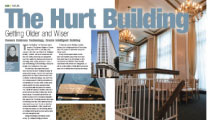
The Hurt Building, Getting Older and Wiser
- 0 Comments
- November 20, 2013
- by Nicole Bencomo
- Leave a comment
The Hurt Building-an Atlanta icon and a member of the National Register of Historic Places since 1977-is not likely what comes to mind when one thinks of an “”intelligent building. However, with smart investments over time, the building ownership and management team have applied the right type and amount of technology, while putting processes in place to use that technology to full advantage, making the building more intelligent as it has aged.
 The first thing most people think about when they hear the term “intelligent building” is advanced technology- lots of it. And what most people picture is a super modern structure with a futuristic architectural design. They don’t think of a building opened in 1913 that exemplifies the craftsmanship of the early 1900s: uninterrupted marble, glazed brick piers, ornamental terra cotta spandrels and heavy decorative cornice. The original 1913 plaster chandelier continues to provide light in the building’s three-story domed rotunda today. The original Coal-Tar-Pitch roof remains in place and the mechanical equipment that operates the 12 building elevators dates back to technology from the 1950s, while the original cabs remain in use. Even the main air handling systems were installed in 1956. Despite these old-fashioned features, the Hurt Building truly is an intelligent building and has been getting wiser as it has been getting older.
The first thing most people think about when they hear the term “intelligent building” is advanced technology- lots of it. And what most people picture is a super modern structure with a futuristic architectural design. They don’t think of a building opened in 1913 that exemplifies the craftsmanship of the early 1900s: uninterrupted marble, glazed brick piers, ornamental terra cotta spandrels and heavy decorative cornice. The original 1913 plaster chandelier continues to provide light in the building’s three-story domed rotunda today. The original Coal-Tar-Pitch roof remains in place and the mechanical equipment that operates the 12 building elevators dates back to technology from the 1950s, while the original cabs remain in use. Even the main air handling systems were installed in 1956. Despite these old-fashioned features, the Hurt Building truly is an intelligent building and has been getting wiser as it has been getting older.
Intelligent Buildings International Journal writes, “An intelligent building provides a sustainable, responsive, effective and supportive environment within which individuals and organizations can achieve their objectives. Technology is fundamental, but is an enabler rather than an end in itself.”
To that end, the Hurt Building combines judicious and strategic application of technology along with people and processes designed to deliver results. Energy retrofits implemented over the years have replaced aging infrastructure and taken advantage of new technologies as they have become cost effective. These included replacement of the chillers and cooling tower, as well as multiple lighting retrofits that have evolved along with the development of lighting technology.
Click Here to read the full article published in Insight, The Commercial Real Estate Journal

0 Comments